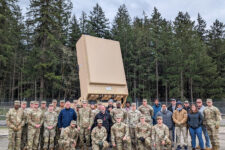Artificial intelligence and technology (Getty images)
WASHINGTON — Nearly six years ago the Director of National Intelligence sponsored a public competition to see how well an algorithm could replicate human-made analytical intelligence reports.
The results wouldn’t be very impressive looking back from the current age of ChatGPT; the best entry, written by a French programmer, looked good but didn’t make all that much sense. Still, at the time the ODNI found the results “highly encouraging.”
Fast forward a half decade and far more advanced algorithms — neural net learning artificial intelligence — are already at work within CIA headquarters, according to a former senior official, even if they’re not pumping out final analytical reports.
RELATED: SOCOM acquisition chief: AI will be ‘key to every single thing’
Linda Weissgold, former CIA deputy director of analysis until her retirement in April, wanted to make it clear that she did not believe AI would ever replace human analysts, mostly because so much of how generative AI comes up with its answers to questions is a mystery even to the programmers.
“Much of what generative AI is producing is a reflection of unknowns at this point, right? It’s not clear what the universe of information is that it’s searching. We don’t know what the programmers parameters and their biases are,” she said in an INSA webinar on Tuesday. “I once served as President [George W.] Bush’s intelligence briefer, and I can’t imagine going in and telling a president in response to a question [like], ‘Why are you saying this?’ ‘Oh I don’t know, because the black box just told me so.’ That’s never going to be acceptable.”
RELATED: ‘Operationalize AI’: DIA signs out artificial intelligence strategy, creating governance model
That said, Weissgold said her answer to the question of AI’s usefulness in intelligence analysis has grown more nuanced. Though she said it will never replace human analysts, Weissgold said generative AI can be a helpful “analytical tool.”
Right now, the 37-year agency veteran said, there are three ways the intelligence community is already using AI to its benefit.
First, she said AI can help analysts find relevant information in “mountains of irrelevant data.”
“It’s double checking that information hasn’t been missed,” she said. “I always dreaded when we were largely using paper files that there was always going to be something found in a safe or folder somewhere after publication” of the analytical product. “Now we have the tools where we can check to say, if you’re reading this, did you see this information out there?”
RELATED: DISA wants to use AI as a ‘digital concierge’ for its workforce
She likened the tool to Amazon’s feature that shows other products a shopper might be interested beyond what they’re currently viewing.
Secondly, AI can help provide an “alert function.”
“Information is happening around the globe 24 hours a day, analysts can’t be at their desks 24 hours a day. So AI is already being used to point something out — ‘You might want to come in and look’ — whether it be on the classified or unclassified systems.”
Lastly, AI has shown itself to be a “remarkable visualization” tool, she said.
“It’s automating some of the drudgery of routine functions of plotting, like, locations of where a unit might be on a map or something along those lines, or where there’s reports of fighting,” she said.
Still, Weissgold said she’d like to see AI pushed further in some tasks. For instance, could it better highlight novelty to analysts, or make novel connections?
“Eventually what I would like to see our AI get to is a capability to point out insights that analysts don’t see: things like, track and tell me this is the first time something’s happened. Or this only happens when ‘x’ occurs in the world. [Those] are the kinds of things that are hard for analysts to kind of keep in their brain or to identify.”
Pentagon seeks to shift $50B in planned funding to new priorities in FY26
Breaking Defense obtained a list of the 17 priority categories that are to be financially protected in FY26.



























